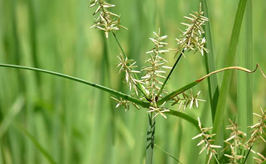Methods of Weed Control
Important weed flora of sugarcane:
Being a long duration crop, it is heavily infested with a variety of weeds. The weed flora differs from location to location due to variation in agro-ecological conditions and management practices. The most important weeds associated with sugarcane crop are:
Grasses: Cynodondactylon(Pers), Digitariasanguinalis, Sorghum halepense(Pers), Setariaglauca, Dactylocteniumaegypticum(Pers), Echinochloacolonum, Eleusineindica, Panicumrepens
Sedges: Cyperusrotundus, Cyperusirria, Fimbristylismiliaceae
Broad leaved weeds:Melilotus alba, Melilotusindica, Eclipta alba, Convolvulus arvensisL., Euphorbia hirta, Chenopodium album L., Ammaniabacifera, Solanumnigrum, Nicotianaplumbaginifolia, Visia sativa, Ipomeahaderacea, Digeraarvensis.
Critical period of crop-weed competition:
Weed infestation during 60-120 days after planting has been found detrimental for cane yield in spring planted sugarcane. In sugarcane ratoon, critical period of crop-weed competition has been identified as 30-50 days after ratoon initiation.
Methods of weed control:
Management of weeds involves prevention as well as control measures to minimize the losses caused due to weed with the minimum disturbance of soil and plant environment, by adopting different mechanical, cultural and chemical methods along with integrated weed management practices.
Mechanical Method:
As sugarcane is a wide spaced crop, shallow rooted weeds can be managed by hoeing with hand tools or with intercultural operations (with tractor/bullock drawn implements) during growing season of crops. Among mechanical methods, hand weeding, digging by spades and inter cultivation by five- tyne cultivator are commonly adopted. Mechanical methods contribute towards maintaining the good physical condition of soil, which is very conducive for the growth of sugarcane besides weed removal. Removal of weeds by hand at 30, 60 and 90 DAP from inter as well as intra-row spaces found best among all the weed control methods at all the locations. However, hand weeding is not much effective against perennials and Cyperusrotundus.
Cultural methods:
Weeds can also be managed through agricultural practices such as crop rotations, crop competition, mulching, clean cultivation, trap cropping etc.
Crop rotation:
Monoculture of sugarcane may lead to severe crop- weed competition. Crop rotation helps to break the weed chain and destroy associated weeds.
Intercropping:
Sugarcane is a wide spaced crop, provides better opportunity for weeds to emerge in a large numbers and infest crops. Inclusion of short duration and quick growing intercrops in these row spaces can suppress weed growth to a greater extent. Wheat, maize, lentil, pea, rajmash, broadbean, linseed, toria, mustard, potato, cabbage, onion and garlic in autumn sugarcane and black gram, green gram, cowpea and sweet potato could be successfully intercropped with spring planted sugarcane.
Trash mulching:
Trash mulching in inter-row spaces of sugarcane not only suppresses the weeds but also check the loss of soil moisture from the surface. The trash of sugarcane @ 7.5 to 10 tonnes/ha should be apply uniformly with an average thickness of 10 cm over soil surface can restricts sunlight and checks weed emergence. Besides, suppressing weeds, trash mulching also conserve soil moisture and provide a potential source of organic matter.
Chemical Method:
The use of selective herbicides has a great scope in eliminating crop-weed competition over a long spell of time and help in increasing the cane yield. Generally, application of single herbicide may not be effective in controlling weeds in sugarcane because of a great diversity in weed flora and the longer duration required to suppress the weeds which come in several flushes. Pre-emergence application of atrazine @ 1.5-2.0 kg/ha or metribuzine @ 1.0 kg/ha followed by 2, 4-D @ 0.75-1.0 kg/ha as post emergence has been found quite effective for broad spectrum weed control in sugarcane.



